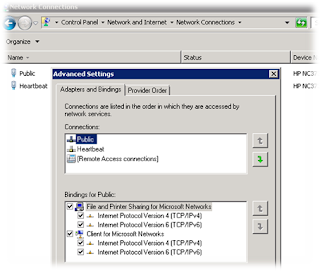Preparing server from scrap.. lemme prepare the checklist first..
in a nutshell...
- Configure RAID – for OS redundancy make sure disks are on raid 1 or 5 selection.
- Install Windows Server 2008 R2 Ent Edn.
- Register OS online
- Install latest patches including SP1 available at the moment.
- Change the windows updates schedule.. Change settings and choose download updates but let me choose whether to install them. This way it would be a controlled restart.
- Join node to domain
- Install Anti-Virus
- If using SAN Storage to present the storage disks to the server you may need to download and install HP MPIO Full Featured DSM for P6x00 family for Disk Arrays. This will present the EVA 4400 SAN Storage Disk to the Server. Or use free iscsi storage initiators see this one. Present it to the server. Format (ntfs) the newly created disk drives. Total 4 drives preferably. i) for Quorum (max 1GB enough), ii) for MSDTC (max 1GB enough), iii) for Log Volume, iv) for Data Volume.
- Create a cluster account and add to domain admin group.
- Node1: Add Features Failover Clustering
- Go to network connections and disable not in use network adapters. Select detailed view and disable netbios on heartbeat network of each nodes. Go to network properties>>ipv4 properties>>advanced>>wins>>disable NetBIOS over TCP/IP.
- Node1&2: Add Application Server Role and Distributed Incoming Remote and Outgoing Remote Transaction Role and .net framework 3.5.1 feature from Server Manager.. if required make sure non-http activation is selected which is used for WCF activation.
- Refer Security considerations before & after SQL Server Installation
- SQL 2008 R2 – proceed with system configuration checker
- Avoid SQL server setup run from remote share.. copy the ISO image locally and run the setup. installation will be faster this way. if required download ISO magic disc for accessing ISO images.
- Install SQL, option: New SQL server failover cluster installation .. Point Data Drive to S.. Point Log Drive to L: If skipped you can do this at a later stage from
- Add mix mode authentication..
- Setup preferred Cluster Node to the more powerful server (say cluster node 1 has more memory, so make it as the preferred owner).
- Group Policy inclusion.. refer automatic restart of service accounts i) Log on as a batch job, ii) Log on as a service, iii) Act as part of the operating system
- Present disable non present network drivers.
- Enable windows firewall and include only required tcp port
- Install SQL to the second node. .option: add node to a SQL server failover cluster
- Segregate SQL service account and include the domain service account credentials for each service. note that passwords are changed once in 3 months (production servers only) or based on companies IT policy.
- If you want SQL named instance on this failover cluster then at this point select the option 1 from SQL setup: "new installation or add features to an existing installation". At command prompt type ssms (for SQL 2008 onwards) or sqlwb (for SQL 2005) and check the connections. You may remotely check the connection by typing "telnet servername port" (default 1433).
- Finally remove internet access from SQL server to minimize external threats.



















